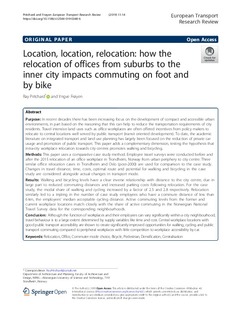| dc.contributor.author | Pritchard, Ray | |
| dc.contributor.author | Frøyen, Yngve Karl | |
| dc.date.accessioned | 2019-03-01T09:09:18Z | |
| dc.date.available | 2019-03-01T09:09:18Z | |
| dc.date.created | 2019-02-21T18:47:48Z | |
| dc.date.issued | 2019 | |
| dc.identifier.citation | European Transport Research Review. 2019, 11 (14), . | nb_NO |
| dc.identifier.issn | 1867-0717 | |
| dc.identifier.uri | http://hdl.handle.net/11250/2588193 | |
| dc.description.abstract | Purpose: In recent decades there has been increasing focus on the development of compact and accessible urban environments, in part based on the reasoning that this can help to reduce the transportation requirements of city residents. Travel intensive land uses such as office workplaces are often offered incentives from policy makers to relocate to central locations well served by public transport (transit oriented development). To date, the academic literature on integrated transport and land use planning has largely been focused on the reduction of private car usage and promotion of public transport. This paper adds a complementary dimension, testing the hypothesis that intra-city workplace relocation towards city centres promotes walking and bicycling. Methods: This paper uses a comparative case study method. Employee travel surveys were conducted before and after the 2015 relocation of an office workplace in Trondheim, Norway from urban periphery to city centre. Three similar office relocation cases in Trondheim and Oslo (post-2000) are used for comparison to the case study. Changes in travel distance, time, costs, optimal route and potential for walking and bicycling in the case study are considered alongside actual changes in transport mode. Results: Walking and bicycling levels have a clear inverse relationship with distance to the city centre, due in large part to reduced commuting distances and increased parking costs following relocation. For the case study, the modal share of walking and cycling increased by a factor of 2.5 and 2.8 respectively. Relocation similarly led to a tripling in the number of case study employees who have a commute distance of less than 6 km, the employees’ median acceptable cycling distance. Active commuting levels from the former and current workplace locations match closely with the share of active commuting in the Norwegian National Travel Survey data for the corresponding neighbourhoods. Conclusion: Although the function of workplaces and their employees can vary significantly within a city neighbourhood, travel behaviour is to a large extent determined by supply variables like time and cost. Central workplace locations with good public transport accessibility are shown to create significantly improved opportunities for walking, cycling and public transport commuting compared to peripheral workplaces with little competition to workplace accessibility by car. | nb_NO |
| dc.language.iso | eng | nb_NO |
| dc.publisher | Springer Open | nb_NO |
| dc.relation.uri | https://etrr.springeropen.com/articles/10.1186/s12544-019-0348-6 | |
| dc.rights | Navngivelse 4.0 Internasjonal | * |
| dc.rights.uri | http://creativecommons.org/licenses/by/4.0/deed.no | * |
| dc.title | Location, location, relocation: how the relocation of offices from suburbs to the inner city impacts commuting on foot and by bike | nb_NO |
| dc.type | Journal article | nb_NO |
| dc.type | Peer reviewed | nb_NO |
| dc.description.version | publishedVersion | nb_NO |
| dc.source.pagenumber | 20 | nb_NO |
| dc.source.volume | 11 | nb_NO |
| dc.source.journal | European Transport Research Review | nb_NO |
| dc.source.issue | 14 | nb_NO |
| dc.identifier.doi | 10.1186/s12544-019-0348-6 | |
| dc.identifier.cristin | 1679721 | |
| dc.description.localcode | © The Author(s). 2019 Open Access This article is distributed under the terms of the Creative Commons Attribution 4.0 International License (http://creativecommons.org/licenses/by/4.0/), which permits unrestricted use, distribution, and reproduction in any medium, provided you give appropriate credit to the original author(s) and the source, provide a link to the Creative Commons license, and indicate if changes were made. | nb_NO |
| cristin.unitcode | 194,61,50,0 | |
| cristin.unitname | Institutt for arkitektur og planlegging | |
| cristin.ispublished | true | |
| cristin.fulltext | original | |
| cristin.qualitycode | 1 | |

